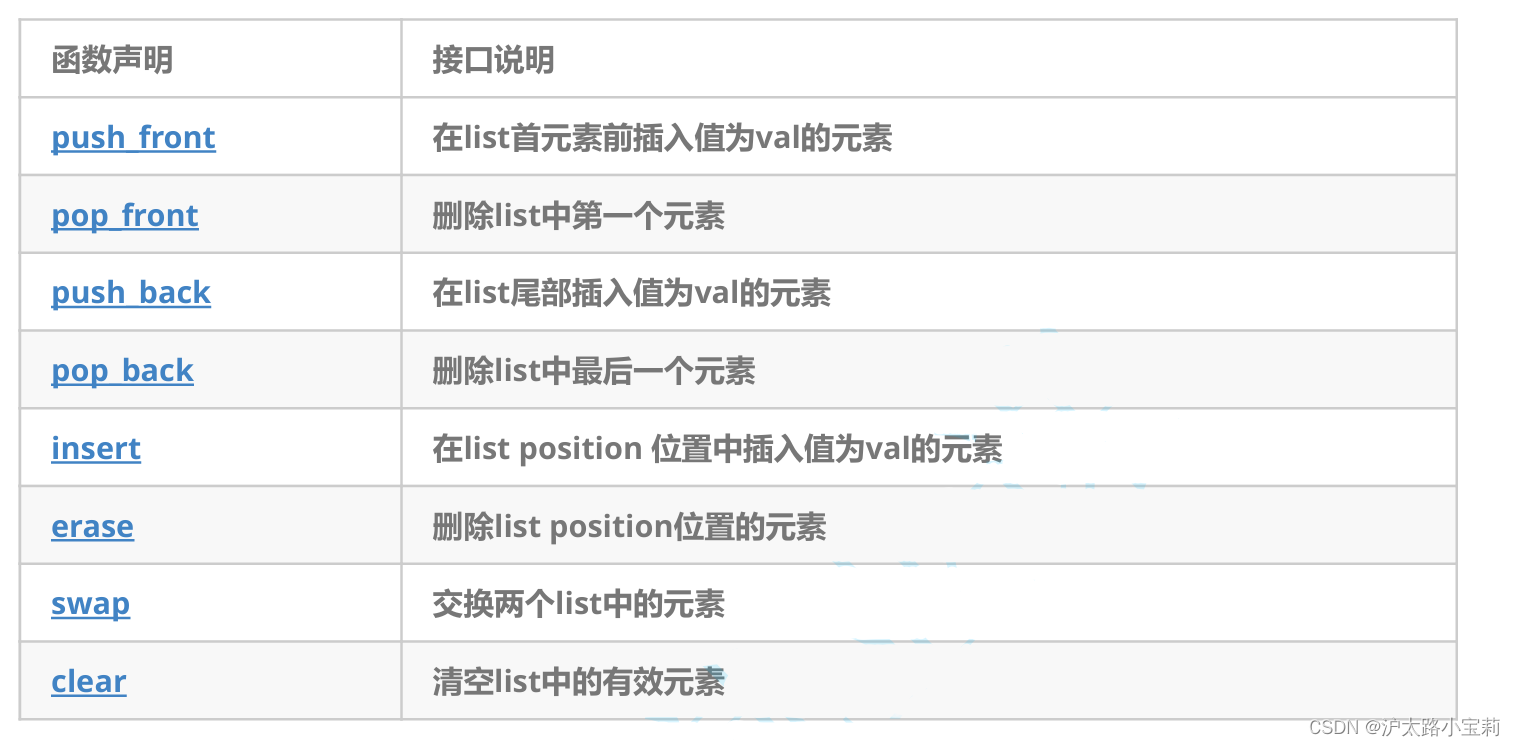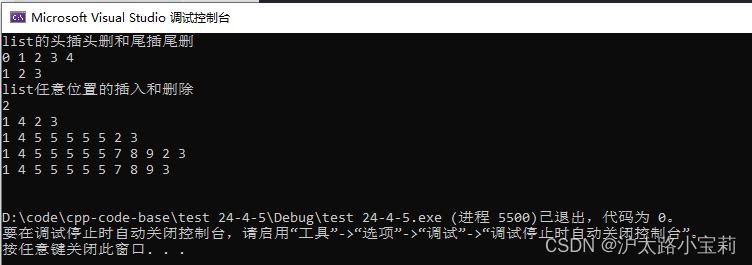一、list的介绍
1. list是可以在常数范围内在任意位置进行插入和删除的序列式容器,并且该容器可以前后双向迭代。
2. list的底层是双向链表结构,双向链表中每个元素存储在互不相关的独立节点中,在节点中通过指针指向 其前一个元素和后一个元素。
3. list与forward_list非常相似:最主要的不同在于forward_list是单链表,只能朝前迭代,已让其更简单高效。
4. 与其他的序列式容器相比(array,vector,deque),list通常在任意位置进行插入、移除元素的执行效率更好。
5. 与其他序列式容器相比,list和forward_list最大的缺陷是不支持任意位置的随机访问,比如:要访问list 的第6个元素,必须从已知的位置(比如头部或者尾部)迭代到该位置,在这段位置上迭代需要线性的时间开销;list还需要一些额外的空间,以保存每个节点的相关联信息。
二、 list常见接口的使用
2.1 list的构造函数

void TestList1()
{
list<int> l1; // 构造空的l1
list<int> l2(4, 100); // l2中放4个值为100的元素
list<int> l3(l2.begin(), l2.end()); // 用l2的[begin(), end())左闭右开的区间构造l3
list<int> l4(l3); // 用l3拷贝构造l4
// 以数组为迭代器区间构造l5
int array[] = { 16,2,77,29 };
list<int> l5(array, array + sizeof(array) / sizeof(int));
// 列表格式初始化C++11
list<int> l6{ 1,2,3,4,5 };
}

2.2 list iterator的使用
此处,可暂时将迭代器理解成一个指针,该指针指向list中的某个节点。

void TestList2()
{
int array[] = { 1, 2, 3, 4, 5, 6, 7, 8, 9, 0 };
list<int> l(array, array + sizeof(array) / sizeof(array[0]));
// 使用正向迭代器正向list中的元素
// list<int>::iterator it = l.begin(); // C++98中语法
auto it = l.begin(); // C++11之后推荐写法
while (it != l.end())
{
cout << *it << " ";
++it;
}
cout << endl;
// 使用反向迭代器逆向打印list中的元素
// list<int>::reverse_iterator rit = l.rbegin();
auto rit = l.rbegin();
while (rit != l.rend())
{
cout << *rit << " ";
++rit;
}
cout << endl;
}
注意:
1. begin与end为正向迭代器,对迭代器执行++操作,迭代器向后移动。
2. rbegin(end)与rend(begin)为反向迭代器,对迭代器执行++操作,迭代器向前移动。
2.3 list 元素访问与容量接口
list不支持任意位置的随机访问 ,因此只提供了front和back接口来访问首尾元素,其他元素的访问需要迭代器++或--操作。


2.4 list 元素修改

void PrintList(const list<int>& l)
{
// 注意这里调用的是list的 begin() const,返回list的const_iterator对象
for (list<int>::const_iterator it = l.begin(); it != l.end(); ++it)
{
cout << *it << " ";
// *it = 10; 编译不通过
}
cout << endl;
}
// list插入和删除
// push_back/pop_back/push_front/pop_front
void TestList3()
{
cout << "list的头插头删和尾插尾删" << endl;
int array[] = { 1, 2, 3 };
list<int> L(array, array + sizeof(array) / sizeof(array[0]));
// 在list的尾部插入4,头部插入0
L.push_back(4);
L.push_front(0);
PrintList(L);
// 删除list尾部节点和头部节点
L.pop_back();
L.pop_front();
PrintList(L);
}
// insert /erase
void TestList4()
{
cout << "list任意位置的插入和删除" << endl;
int array1[] = { 1, 2, 3 };
list<int> L(array1, array1 + sizeof(array1) / sizeof(array1[0]));
// 获取链表中第二个节点
auto pos = ++L.begin();
cout << *pos << endl;
// 在pos前插入值为4的元素
L.insert(pos, 4);
PrintList(L);
// 在pos前插入5个值为5的元素
L.insert(pos, 5, 5);
PrintList(L);
// 在pos前插入[v.begin(), v.end)区间中的元素
vector<int> v{ 7, 8, 9 };
L.insert(pos, v.begin(), v.end());
PrintList(L);
// 删除pos位置上的元素
L.erase(pos);
PrintList(L);
// 删除list中[begin, end)区间中的元素,即删除list中的所有元素
L.erase(L.begin(), L.end());
PrintList(L);
}
2.5 list 迭代器失效
list的erase操作会导致迭代器失效。迭代器失效即迭代器所指向的节点的无效,即该节点被删除了。因为list的底层结构为带头结点的双向循环链表,因此在list中进行插入时是不会导致list的迭代 器失效的,只有在删除时才会失效。并且失效的只是指向被删除节点的迭代器,其他迭代器不会受到影响,详细说明请看list的迭代器失效。
三、list的模拟实现
3.1 list节点的定义
template<class T>
struct ListNode {
ListNode<T> * _next;//指向下一个节点的指针
ListNode<T> * _prev;//指向前一个节点的指针
T _data;//节点的数据
ListNode(const T& x=T())
:_next(nullptr)
,_prev(nullptr)
,_data(x)
{}
};3.2 list迭代器的封装
由于list的底层空间不连续,其迭代器++或--等运算符需要重载。所以不可以直接使用原生指针(直接定义出来的指针)typedef后作为迭代器。需要对原生指针进行封装,并重载运算符。
template <class T,class Ref,class Ptr>
struct __list_iterator {
typedef ListNode<T> Node;
typedef __list_iterator<T, Ref, Ptr> self;
//这里的Ref和Ptr分别为operator*()和operator->()的返回值类型
Node* _node;//迭代器的本质是结点指针
__list_iterator(Node* x)
:_node(x)
{}
//++it
self& operator++() {
_node = _node->_next;//让_node指向下一个节点
return *this;
}
self operator++(int) {
self tmp(*this);
_node = _node->_next;
return tmp;
}
self& operator--() {
_node = _node->_prev;//让_node指向前一个节点
return *this;
}
self operator--(int) {
self tmp(*this);
_node = _node->_prev;
return tmp;
}
Ref operator*() {
return _node->_data;//返回节点数据
}
Ptr operator->() {
return &_node->_data;//返回节点数据的地址
}
bool operator!=(const self& s) {
return _node != s._node;
}
bool operator==(const self& s) {
return _node == s._node;
}
};这里list迭代器类模板传递了三个参数,通过对三个参数的控制来实现迭代器的泛型编程,如下:
typedef __list_iterator<T, T&, T*> iterator;
typedef __list_iterator<const T, const T&, const T*> const_iterator;传递const类型时会实例化为const_iterator,利用迭代器*和->访问元素时不可修改。
3.3 list完整代码实现
template<class T>
struct ListNode {
ListNode<T>* _next;
ListNode<T>* _prev;
T _data;
ListNode(const T& x = T())
:_next(nullptr)
, _prev(nullptr)
, _data(x)
{}
};
template <class T, class Ref, class Ptr>
struct __list_iterator {
typedef ListNode<T> Node;
typedef __list_iterator<T, Ref, Ptr> self;
Node* _node;
__list_iterator(Node* x)
:_node(x)
{}
//++it
self& operator++() {
_node = _node->_next;
return *this;
}
self operator++(int) {
self tmp(*this);
_node = _node->_next;
return tmp;
}
self& operator--() {
_node = _node->_prev;
return *this;
}
self operator--(int) {
self tmp(*this);
_node = _node->_prev;
return tmp;
}
Ref operator*() {
return _node->_data;
}
Ptr operator->() {
return &_node->_data;
}
bool operator!=(const self& s) {
return _node != s._node;
}
bool operator==(const self& s) {
return _node == s._node;
}
};
template<class T>
class list {
typedef ListNode<T> Node;
public:
typedef __list_iterator<T, T&, T*> iterator;
typedef __list_iterator<const T, const T&, const T*> const_iterator;
iterator begin() {
return _head->_next;
}
iterator end() {
return _head;
}
const_iterator begin() const {
return _head->_next;
}
const_iterator end() const {
return _head;
}
void empty_init() {
_head = new Node;
_head->_next = _head;
_head->_prev = _head;
}
list() {
empty_init();
}
void clear() {
iterator it = begin();
while (it != end()) {
it = erase(it);
}
}
~list() {
clear();
delete _head;
_head = nullptr;
}
list(list<T>& lt) {
empty_init();
for (const auto& e : lt) {
push_back(e);
}
}
void swap(list<T>& tmp) {
std::swap(_head, tmp._head);
}
list<T>& operator=(list<T> lt) {
swap(lt);
return *this;
}
void push_back(const T& x) {
/*Node* newnode = new Node(x);
Node* tail = _head->_prev;
tail->_next = newnode;
newnode->_prev = _tail;
newnode->_next = _head;
_head->_prev = newnode;*/
insert(end(), x);
}
void push_front(const T& x) {
insert(begin(), x);
}
void pop_back() {
erase(--end());
}
void pop_front() {
erase(begin());
}
//prev newnode cur
iterator insert(iterator pos, const T& x) {
Node* cur = pos._node;
Node* prev = cur->_prev;
Node* newnode = new Node(x);
prev->_next = newnode;
newnode->_prev = prev;
newnode->_next = cur;
cur->_prev = newnode;
return newnode;
}
iterator erase(iterator pos) {
assert(pos != end());
Node* cur = pos._node;
Node* prev = cur->_prev;
Node* next = cur->_next;
prev->_next = next;
next->_prev = prev;
delete cur;
return next;
}
private:
Node* _head;
};




















 354
354











 被折叠的 条评论
为什么被折叠?
被折叠的 条评论
为什么被折叠?








